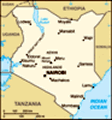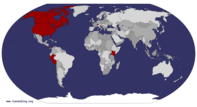Advertisement
I am fortunate to have my wife as a travel companion, because my trip to Kenya would have never got me past the squalor of the first Tusker laden bar that I encountered in the beautiful smog ridden city of Nairobi. With my wife’s encouragement, we booked a 12 night deluxe “flying safari” for two via The Africa Adventure Company for the undesirable price of $9,300US. Our itinerary had us visiting Nairobi, Mt. Kenya (Naro Moru), Samburu, and Maasai Mara. The price did not include our activities in Nairobi or gratuities (add a couple thousand dollars to our already exorbitant total), so our vacation was in no way a discounted event. We probably could have saved a few thousand dollars if we booked our own accommodations and air travel thru the Safarlink Airlines website or via our on location tour company: Origins Travel.
In preparation for our travels we got a few thousand dollars worth of vaccinations and medications for preventing diseases such as Meningitis, Yellow Fever, Typhoid, Polio Booster, MMR, Hepatitis A, Hepatitis B, Altitude Medicine, Traveler’s Diarrhea Medicine, and Malaria Medicine.
It seems Kenya does not require its entrants to provide proof that they have received a
Yellow Fever vaccination, and entry Visas are available on location, so no preparation is required to enter the country.
We stayed at the Fairview Hotel, one of Nairobi’s finest hotels, for the first two nights of our visit. Upon our arrival to the hotel, we needed to pass thru a roadside security checkpoint and have our bags x-rayed and we were asked to pass thru a metal detector. The security measures were effective, considering the fact that they managed to confiscated most of my weapons and contraband right there on the spot.
We had one full day in Nairobi before departing to Naro Moru, so we decided to hire a private taxi at a cost of $140US for the day and we visited the local tourist sites. Our first stop was the Daphne Sheldrick Elephant Orphanage. You can only visit the orphanage for one hour from 11:00am-Noon, but if you adopt an elephant ($50 annual fee), you can arrange a private visit for yourself to the orphanage in the evening. The nearby Giraffe Center was our next stop. Here they let you hand feed the animals. I’m not sure about health safety, but it’s worth the risk of
acquiring giraffe rabies for such an unimaginable unforgettable experience. Entry fees for the Elephant Orphanage and the Giraffe Center were minimal, but our last stop at the Safari Walk was $20 per person. The Safari Walk borders Nairobi National Park and it’s basically a very well maintained zoo that provides limited viewing of open parklands. In the evening (before dark) we took a walk thru Uhuru Park, and we concluded that the downtown area of Nairobi is relatively safe, considering the fact that most local residents use walking as their primary form of transportation, thus the sidewalks are packed with people. A crowded sidewalk is not the most conducive environment for aiming criminal activity at tourists, so we felt safe.
The next day we flew out of Nairobi’s Wilson Airport to the Nanyuki Airport near Naro Moru. We used this town as a launch point for hiking to Point Lenana (16,335 ft.) which is the highest peak in Kenya that can be reached without specialized climbing skills and equipment (the nearby Mt. Kenya peak is the highest in Kenya). We booked our four night trip up and down the Naro Maro River Trail thru the Naro Moru River Lodge
and our guide (Richard) and our porters (Henry, James, and Anthony) were amazing. The food that they provided was incredible. We stayed in permanent mountain huts, so we didn’t need to bring our tent. We did need sleeping bags and very warm clothing.
Lower: wool underwear, jeans, and waterproof pants
Upper: wool underwear, t-shirt, aloha shirt, waterproof shell
Extras: winter hat and light gloves
Our final ascent began at 3am, and altitude sickness was the flavor of the day. We were climbing during the rainy season which is winter on Mt. Kenya therefore we encountered hard snow upon our ascent. For the last few hundred feet of our climb, it was insistent that no mistakes were made, as we would suffer a very long fall down the mountain if we slipped, so we all took it very carefully and slow. In the summer, permanent ropes are exposed for this section of the climb, but the snow covered the ropes and made them inaccessible, so the danger factor seemed much higher than it typically would be. Our travel agency recommended that we tip our guide and porters a total of $300 per a climber ($600 total), but because they did an
unbelievable job, we gave them a total of $800.
We sandwiched our trek up Point Lenana with accommodations at the Naro Moru River Lodge, which is an incredible place. Then we left via a private charter flight from the Naro Moru area to enjoy few days of 4WD safaris in Samburu. We booked two nights in luxury tents at the Intrepids in Samburu and the experience was out of this world. We were driven by seriously the most amazing guide on earth. His name is “Jelly”, and if you go there you have to request him. He knows tons about the animals and the surrounding environment and he will go above and beyond to make sure you see everything you can. The facilities, service, and food at the Intrepids Samburu was extraordinary, so it comes highly recommended. We also visited a local Samburu village at a cost of $40 per person ($80 total). Meeting these incredible people is well worth the fee (they get a large portion of it, so you can look at the fee as a donation), and it’s definitely the experience of a lifetime. We made sure to tip our guide well ($60 a day for
two people on a private tour is recommended - but we tipped more because the service was outstanding).
We next flew to the Intrepids in Maasai Mara for a two night stay there. The employees at this resort did not have the same authentic good natured vibe that we felt from the Samburu location, so the experience was a bit less fulfilling. The Maasai Mara savannah is open and vast and does not provide the viewer with the same element of surprise as Samburu, so it also wasn’t quite as exciting, but the wildlife was incredible. We did have an interesting safari drive where we got stuck in the mud along with three other “rescue” vehicles and drove back to our tents at night. The situation was surreal as we could see the glow of the animals eyes that we encountered along the way as we got a complimentary “night safari” a.k.a. our drive back to the hotel.
Our final night was spent at the Sarova Panafric Hotel in downtown Nairobi. I have a generally have a rastaman’s diet (fish and vegetables), but for this trip I decided to avoid the complexity of ordering with special dietary concerns.
It’s good to mention though that vegetarians can easily find suitable meals in Kenya. In any case, we spent our first evening back in Nairobi at the Carnivore Restaurant where exotic meats such as ostridge, crocodile, and ox testicles are served until you can’t eat anymore. The following day we got a chance to walk downtown and do some shopping at the City Market and visit the National Museum. We also took a taxi to the Animal Orphanage at the Nairobi National Park where you can watch the animals get fed (especially the lions) from 3:00pm-4:00pm.
Our trip ended with an overnight trip to Switzerland (see prior blog) and then we returned to Boston. A few odd things to note are:
1. Nairobi is famous for it’s traffic. You can find entertainment with the vendors who pop out of the woodwork when traffic comes to a stop and try to sell you everything from household decorations to tupperware.
2. Most hotels require you to take an odd mini-step up to get into the room, so expect to trip over this unusual “step” every now and again.
3. We traveled in the rainy season but didn’t get much rain.
We got stuck in an occasional evening shower at every one of our destinations, but we did not see enough rain to ruin our vacation. Maasai Mara was exceptionally cold for our evening drives, but if you dressed accordingly, it wasn’t an issue.
4. I didn’t list the animals we saw on our safari drives because we saw everything. If you do as many drives as we did you will most likely see Antelope, Wilderbeast, Hyenas, Lions, Mongoose, Zebras, Giraffes, etc... etc.... etc...
Tipping Guidelines: View Guidelines on Scribd Download Books: Travel Book - Basic Travel Book - Advanced Learn Swahili
Advertisement
Tot: 0.162s; Tpl: 0.019s; cc: 10; qc: 47; dbt: 0.1112s; 1; m:domysql w:travelblog (10.17.0.13); sld: 1;
; mem: 1.2mb














